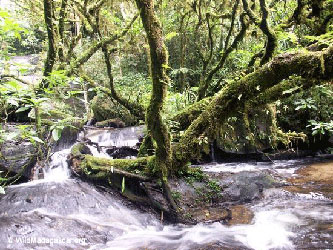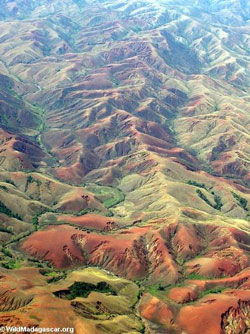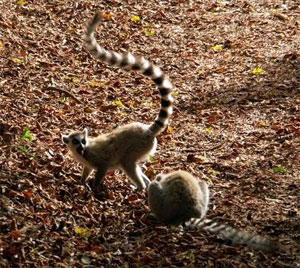UNESCO lists rainforests of Madagascar as Heritage sites
UNESCO lists rainforests of Madagascar as Heritage sites
Rhett A. Butler, mongabay.com
July 3, 2007
UNESCO has listed six rainforest parks in Madagascar as World Heritage sites. The announcement comes as the Indian Ocean island nation has moved aggressively to protect its biologically-rich forests from further degradation.
Madagascar, larger than California and about size the size of Texas or France, is the world’s fourth largest island. Isolated in the Indian Ocean off the coast of southern Africa, about 70% of the estimated 250,000 species found on the island exist nowhere else on the globe. Madagascar is home to evolutionary oddities like the fossa, a carnivorous mammal that looks like a cross between a puma and a dog but is closely related to the mongoose; the indri, a cat-sized lemur that leaps from tree to tree with ease and sings eery, whale-like songs; the sifaka, a lemur, that swears rudely but dances like a ballet performer; and the streaked tenrec, a spiny yellow and black insectivore that resembles a miniature hedgehog and makes grinding-chirping noises when threatened. The island has baobab trees, which look like they’ve been planted upside down; the rosy periwinkle, a delicate flower used to cure pediatric leukemia and Hodgkin’s disease; and an entire desert ecosystem consisting of just spiny plants.
 Ranomafana National Park. Photo by Rhett A. Butler |
While Madagascar’s fauna is brilliant and spectacular, it is also highly endangered. Significant forest loss has put many of the island unique species and ecosystems on the brink of extinction.
Madagascar’s disappearing wild lands result not from loggers, large-scale soybean farmers, or other forms of commercial exploitation, but from the actions rural families whose very survival is dependent upon subsistence use of the natural resources that surround them. Most Malagasy never have an option to become a doctor, computer programmer, factory worker, or secretary; they must live off the land and make use of whatever they can. Their day-to-day needs cost the country and the world through the loss of the island’s remarkable biodiversity.
Over the past several hundred years Madagascar has lost its largest animals to extinction due to hunting and habitat conversion. The list includes gorilla-sized lemurs, gigantic tortoises, pygmy hippos, and the enormous Elephant bird (Aepyornis maximus) that stood ten feet (3m) tall, weighed over 1100 pounds (500 kg), and laid an egg large enough to make an omelette to feed 150 people. All these species went extinct after humans reached the island.
While is too late for some of Madagascar’s most magnificent species, the country had recently achieved a conservation milestone — one that may help prevent further disappearances, while possibly improving the livelihoods of some of the country’s poorest people.
With last year’s official establishment of the Makira Protected Area, an expanse of rainforest in the northeastern part of the country, the government of Madagascar has brought the total area of land and marine zones under protection to one million hectares (3,800 square miles). The protected areas include some of the island’s most important ecosystems and will play an important role in the country’s nascent ecotourism industry. Through its network of parks and reserves, Madagascar hopes to significantly increase the number of travelers who come to observe lemurs, chameleons, and other native wildlife in their natural habitat.
 Deforestation in Madagascar. Photo by Rhett A. Butler |
The latest UNESCO designation caps a broader conservation and sustainable development initiative first unveiled by President Marc Ravalomanana at the World Parks Congress in Durban, South Africa in 2003. In a speech that surprised most observers, Ravalomanana pledged to triple the size of Madagascar’s nature reserves by 2008 to cover 10 percent of the country’s total land area. Shrewdly telling delegates that “We can no longer afford to sit back and watch our forests go up in flames… This is not just Madagascar’s biodiversity, it is the world’s biodiversity,” Ravalomanana convinced donors that saving Madagascar’s wild places was going to require support from the international community — support which he has since found.
In adopting a pro-conservation stance, Ravalomanana saw well beyond the protection of a few flagship species, envisioning an environment where the Madagascar economy would benefit from sustainable development. Sustainable development and responsibly managed ecotourism can generate revenue and employ large numbers of local people without causing significant environmental damage. In Madagascar, local communities benefit directly from ecotourism through their 50% share of park entrance fees (park entry fees are divided equally between the parks service and local communities), sales of handicrafts and “tourist items,” and employment as porters, wildlife guides, park rangers, workers in the service force of hotels, restaurants and lodges. Ecotourism has great potential to diversify Madagascar’s economy beyond its current limited number of agricultural and mineral exports, while protecting its amazing natural assets.
New UNESCO World Heritage Site in Madagascar: the Rainforests of the Atsinanana
 Ring-tailed lemurs in Madagascar. Photo by Rhett A. Butler |
UNESCO selected six parks–Andohahela, Andringitra, Marojejy, Masoala, Ranomafana, and Zahamena–to represents the “Rainforests of the Atsinanana” World Heritage Site in Madagascar. Together these parks hold more than one percent of the planet’s biodiversity.
“The Rainforests of the Atsinanana comprise six national parks distributed along the eastern part of the island. These relict forests are critically important for maintaining ongoing ecological processes necessary for the survival of Madagascar’s unique biodiversity, which reflects the island’s geological history,” stated UNESCO.
“Inscribed both for their importance to ecological and biological processes, the rainforests are also inscribed for their biodiversity and the threatened species they support. The rate of endemism within these forests is exceptionally high at 80 to 90 percent for all groups. The property is of global significance for fauna, especially primates,” it said.
The parks
Andohahela National Park: Located in the southeast of the island, Andohahela National Park has dense tropical rainforest and Madagascar’s unique spiny forest, a dry ecosystem characterized by thorny plants–95 percent of which are endemic to the habitat.
Andringitra National Park: Andringitra National Park is located in southeastern Madagascar and characterized by high mountains (peak 2658m), deep valleys, and ridges. One of the most biodiverse parks in Madagascar, Andringitra is made up of three distinct ecozones: low altitude rainforest, montane mountain, and highland forest. Andringitra is home to more than 100 species of birds, 55 kinds of frogs, and 13 types of lemurs.
Marojejy National Park: Marojejy is one of Madagascar’s most beautiful and biodiverse protected areas due to its mountainous terrain. Vegetation types range from lowland rainforest to moorland mountain thicket vegetation. 60 species of frogs, 47 mammals, and 116 mammals have been documented in the park.
Masoala National Park: The Masoala Peninsula is one of the most biodiverse places on earth. The tropical rainforests extend from the white sand beaches of the Bay of Antongil to the mountainous center 1224 meters above sea level. Within the park visitors can find ecosystems ranging from coral reefs to mid-altitude rainforests. It is estimated that the forests of the Antongil Bay watershed contain 50% of Madagascar’s biodiversity, despite making up less than 2% of its land mass.
Ranomafana National Park: Ranomafana is one of Madagascar’s best known and most important parks. Created in 1991 following the 1986 discovery of the golden bamboo lemur, Ranomafana has served as a model for subsequent parks and reserves in the country and abroad. 114 species of birds and 12 kinds of lemurs have been recorded in the park.
Zahamena National Park: Located in eastern Madagascar, Zahamena National Park has 13 species of lemurs.